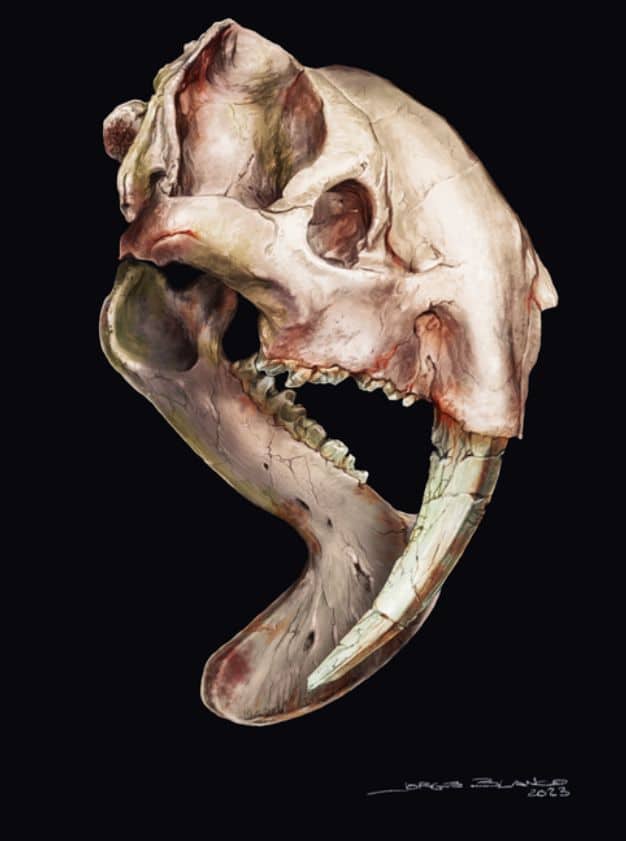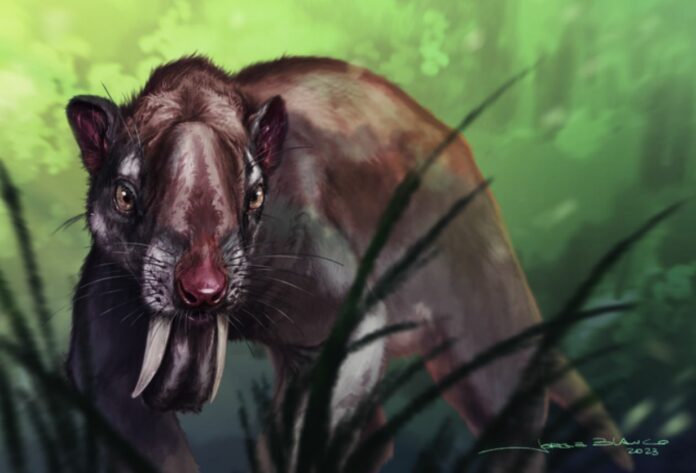New Study Explores How the Marsupial Sabertooth Thylacosmilus Adapted for Hunting with Wide-Set Eyes
A recent study delves into the visual capabilities of the Thylacosmilus atrox, an extinct carnivorous marsupial with herbivore-like, wide-set eyes. Despite this anatomical peculiarity, the species boasted large canines that extended above its skull and enabled effective hunting. Carnivorous animals typically possess forward-facing eye sockets, which aid in stereoscopic or 3D vision, an advantageous trait for hunting prey.
Researchers from the American Museum of Natural History and the Instituto Argentino de Nivología, Glaciología, y Ciencias Ambientales in Mendoza, Argentina, examined whether the Thylacosmilus atrox could also see in 3D.
The study’s findings were published in the journal Communications Biology.

The Thylacosmilus, an extinct carnivorous marsupial with remarkably large upper canines that resemble those of the famous placental sabertooth from North America, earned the moniker “marsupial sabertooth.”
It roamed South America until it disappeared around three million years ago and belonged to the Sparassodonta, a group of carnivorous mammals related to living marsupials. Although sparassodonts came in various sizes, with the Thylacosmilus potentially weighing up to 100 kilograms (220 pounds), most had forward-facing eyes that likely provided full 3D vision, similar to cats and dogs.
However, the Thylacosmilus had lateral-facing orbits more commonly seen in herbivores, causing its visual fields to overlap insufficiently for the brain to integrate them in 3D. As a supposed hypercarnivore, with a diet estimated to comprise at least 70% meat, Thylacosmilus’s unusual adaptation raised questions.
Researchers from Argentina and the United States sought to uncover an explanation.
“You can’t understand cranial organization in Thylacosmilus without first confronting those enormous canines,” explains lead author Charlène Gaillard. “They weren’t just large; they were ever-growing, to such an extent that the roots of the canines continued over the tops of their skulls. This had consequences, one of which was that no room was available for the orbits in the usual carnivore position on the front of the face.”
Using CT scanning and 3D virtual reconstructions, Gaillard analyzed the orbital organization of several ancient and contemporary mammals, including Thylacosmilus, to compare their visual systems with those of other carnivores and mammals in general. Although certain modern carnivores exhibit low orbital convergence, Thylacosmilus’s convergence was exceptionally low, measuring around 35 degrees, in contrast to the typical predator, such as a cat, with a convergence of roughly 65 degrees. However, the quality of stereoscopic vision also relies on frontation, which refers to the orientation of the eyeballs within the orbits.
“Thylacosmilus was able to compensate for having its eyes on the side of its head by sticking its orbits out somewhat and orienting them almost vertically, to increase visual field overlap as much as possible,” adds co-author Analia M. Forasiepi. “Even though its orbits were not favorably positioned for 3D vision, it could achieve about 70 percent of visual field overlap—evidently, enough to make it a successful active predator.”
“Compensation appears to be the key to understanding how the skull of Thylacosmilus was put together,” points out study co-author Ross D. E. MacPhee.
“In effect, the growth pattern of the canines during early cranial development would have displaced the orbits away from the front of the face, producing the result we see in adult skulls.
“The odd orientation of the orbits in Thylacosmilus actually represents a morphological compromise between the primary function of the cranium, which is to hold and protect the brain and sense organs, and a collateral function unique to this species, which was to provide enough room for the development of the enormous canines.”
The lateral displacement of the orbits was not the only alteration to Thylacosmilus’s skull structure to accommodate its oversized canines while maintaining other functions. The eyes’ position on the skull’s side brings them near the temporal chewing muscles, which could result in deformation during eating. To address this, certain mammals, including primates, have developed a bony structure that separates the eye sockets from the sides. Thylacosmilus did the same, representing another instance of convergence between unrelated species.
This leads to the final query: why would developing massive, ever-growing teeth that necessitated a complete skull reconstruction serve a purpose?
“It might have made predation easier in some unknown way,” adds Gaillard, “But, if so, why didn’t any other sparassodont—or for that matter, any other mammalian carnivore—develop the same adaptation convergently?
“The canines of Thylacosmilus did not wear down, like the incisors of rodents. Instead, they just seem to have continued growing at the root, eventually extending almost to the rear of the skull.”
Forasiepi adds this point, saying, “To look for clear-cut adaptive explanations in evolutionary biology is fun but largely futile. One thing is clear: Thylacosmilus was not a freak of nature, but in its time and place it managed, apparently quite admirably, to survive as an ambush predator. We may view it as an anomaly because it doesn’t fit within our preconceived categories of what a proper mammalian carnivore should look like, but evolution makes its own rules.”
Image Credit: Jorge Blanco
